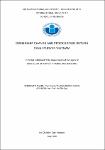| dc.description.abstract | This study investigates the effect of change in state-ownership on the excess return of listed State-owned enterprises. A data of 12 observations of state-owned enterprises (SOEs) with publicly traded shares on the Ho Chi Minh Stock Exchange (HOSE), Ha Noi Stock Exchange (HNX) and Unlisted Public Company Market (UPCoM) is used over a period, from 2014 to 2018. There were many previous studies conducted to state the correlation between the state ownership in SOEs capital structure and SOEs value (Trien Le and Amon Chizema, 2011; Huang and Xiao (2012); Hess et al., 2010); otherwise the influence of foreign ownership on firm performance (David Greenaway et al., 2009; Phan Huu Viet, 2009; Phung and Le, 2013).
This study is distinct to previous studies when it examines how the change of state ownership via divestment events impact on State-owned enterprise with 2 scenarios: the attendance and the absence of foreigners in SOEs ownership structure based on event study methods. This approach is applied here in order to assess the change in excess return in pre and post divestment events for identifying any influence of ownership change when the state publicly announces the related information. Based on a sample of 58 events during 3 main timeframes [-5, +5]; [-10; +10]; [-20; +20] indicated pre and post news period, the paired comparison analysis show that the divestment events don’t have significant influence to stock excess return in overall even with the foreigners participation. However, when examining closely for each enterprise, the results are varied with different news. The announcements about “Initial price for the public auction”, “Last registration day for the public auction”, “Acceptance on the divestment strategy”, “Executive day of divestment” has positive impacts over VNM, SAB, DIG and GEX, respectively; in contract, the announcement related to BMP auction as “Initial auction price, Postpone the auction and reveals the foreign partners” receives pessimistic reaction from the investors. On other cases, the results are quite complex when other announcements related to register, sell and complete divestment procedures expose positive influence in FDG, VCG and KSB, respectively; while records negative side in NBS, HDC. Besides, the market excess return is also a considerable factor when the SOEs excess return are positive explained by market excess return ranged from 12.9% to 17.9%, measured by R-squared index in simple regression model. These findings shed a
light for individual investors trading strategy during divestment period; two most important factors are market conditions and relative participation of foreign capital inflow or appearance of influential institutional investors. From these empirical results, it implies that investors should be aware that not all information could help them to beat the stock market over short run; they need to enhance their analysis ability when approach new information to identify the valuable ones for investment decision and avoid “availability bias”. Last but not least, following the market trend is reasonably important as in the bear market the probability of winning in stock market is just 25% (William J. O'Neil, 2011), which will reduce the market risk for individual investors.
Keywords: Event study, Stock excess returns, related divestment news and state-owned enterprises | en_US |


